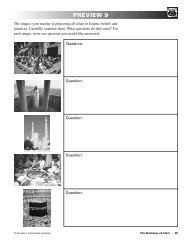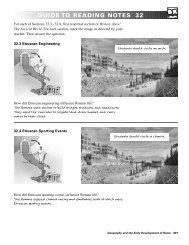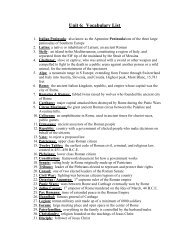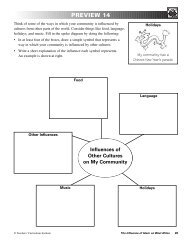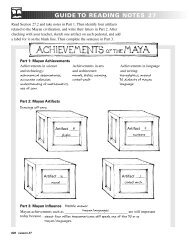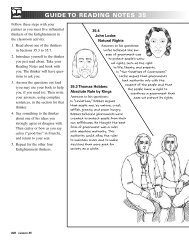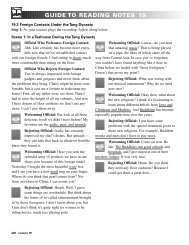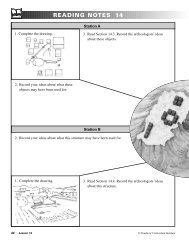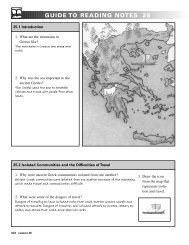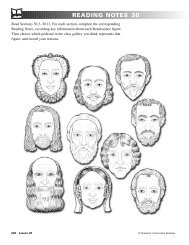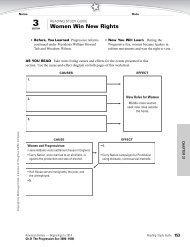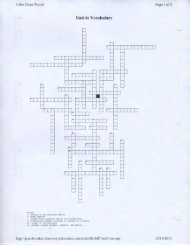Outside Influence on Japan
Outside Influence on Japan
Outside Influence on Japan
Create successful ePaper yourself
Turn your PDF publications into a flip-book with our unique Google optimized e-Paper software.
Name:<br />
------------------<br />
..<br />
Period: ·· Date:<br />
---- ----------<br />
The <str<strong>on</strong>g>Influence</str<strong>on</strong>g> of Neighboring Cultures <strong>on</strong> <strong>Japan</strong><br />
Cultural Diffusi<strong>on</strong> to <strong>Japan</strong><br />
• Many cultural ideas traveled to <strong>Japan</strong> from the------<br />
Peninsula.<br />
• Many of these ideas originally came from------- and<br />
• From China, <strong>Japan</strong> learned about--------<br />
• Buddhist priests brought<br />
to <strong>Japan</strong> 1,000 years<br />
after it was founded.<br />
• -------came to power in 593 C. E .<br />
• He admired Korean and Chinese culture.<br />
• In 607 C. E. he sent an official representative to the<br />
--------court.<br />
• He encouraged upper-class <strong>Japan</strong>ese to travel to China to learn<br />
literature, art, philosophy and-------<br />
<strong>Japan</strong>ese interest in other cultures<br />
• Even before Prince Shotoku, <strong>Japan</strong> had interacti<strong>on</strong>s with the Asian<br />
mainland.<br />
• Knowledge of C<strong>on</strong>fucianism and. Buddhism came from the<br />
-------- Peninsula.<br />
• Also advanced ir<strong>on</strong>working and------- working.<br />
• <strong>Japan</strong> was originally an-------society.<br />
• People grew<br />
and other crops.<br />
• Upper classes owned--------·.<br />
• Family life was centered around the-------' as father's<br />
generally lived away from the family.<br />
• <strong>Japan</strong> was not a<br />
country.<br />
• Power was divided am<strong>on</strong>g chiefs of clans called-------<br />
Government: Imitating the Chinese System<br />
• Like China, <strong>Japan</strong> also had-------<br />
• In China the emperor was------- ruler.
• In <strong>Japan</strong> the emperor <strong>on</strong>ly had<br />
c<strong>on</strong>trol over<br />
semi-independent clans, the uji.<br />
• Uji leaders struggled am<strong>on</strong>g themselves for the right to select<br />
the emperor and influence his .<br />
• During the ih and gth centuries <strong>Japan</strong> started using a Chinese style of<br />
government where the emperor was the<br />
ruler and set<br />
ranks for governmental officials.<br />
• The Taikia Reforms helped<br />
the central<br />
government.<br />
• Land------- was taken away from the lords and given<br />
to the emperor.<br />
City Design<br />
• After the <strong>Japan</strong>ese central government was str<strong>on</strong>ger, they needed a new<br />
• The city became a smaller versi<strong>on</strong> of ______ _<br />
• It became known as<br />
-------<br />
• Nara had an orderly checkerboard------- pattern for it's<br />
streets.<br />
• A wide central boulevard ran down the. center.<br />
• The northern secti<strong>on</strong> had<br />
temples and<br />
m<strong>on</strong>asteries near the imperial pa.lace buildings.<br />
• The <strong>on</strong>ly difference besides the size was that Nara did not have a<br />
Buddhism and Shinto<br />
• <strong>Japan</strong>'s original religi<strong>on</strong> is-------<br />
• This religi<strong>on</strong> expresses the love and respect of the <strong>Japan</strong>ese for<br />
• Worships spirits called----------<br />
• Kami are things like wind, lightning, trees, the<br />
-------, and other important people.<br />
_________<br />
• Shinto stresses purifying whatever is-,..-------<br />
..;....<br />
• Buddhists see life as full of and
• It taught that life is an------- cycle of birth, death, and<br />
rebirth.<br />
• If you led a bad life, you would be .reborn into something<br />
• If you were respectful to others, acted rightly, and achieved<br />
wisdom through meditati<strong>on</strong> you can eventually achieve<br />
-------and never be born again.<br />
Buddhism comes to <strong>Japan</strong><br />
• In 552 a Korean king sent the <strong>Japan</strong>ese emperor a statue of the<br />
-------and a recommendati<strong>on</strong> for the new religi<strong>on</strong>. ·<br />
• The statue arrived with chanting m<strong>on</strong>ks, books of prayer, g<strong>on</strong>gs,<br />
and banners.<br />
• The emperor had not<br />
anything like this before.<br />
• The expressi<strong>on</strong> <strong>on</strong> the Buddha's face was of severe<br />
he<br />
thought it should be worshiped.<br />
• There was great c<strong>on</strong>troversy but eventually it was admired for it's<br />
wisdom and rituals.<br />
• Buddhism did not<br />
Shinto, the two blended<br />
together.<br />
<str<strong>on</strong>g>Influence</str<strong>on</strong>g>s of Chinese Language and Poetry·<br />
• Ancient <strong>Japan</strong>ese was <strong>on</strong>ly a _______ language.<br />
• Written documents were written in-------' whiCh they<br />
learned from Korean scholars.<br />
• The <strong>Japan</strong>ese started using<br />
, or "Chinese<br />
writing." to write <strong>Japan</strong>ese words.<br />
• Eventually started using<br />
, or "borrowed 1E~tters."<br />
which used simplified Chinese characters to stand for syllables.<br />
• Earliest <strong>Japan</strong>ese poems are from the ih and gth centuries. They used<br />
Chinese characters to develop-------<br />
• Tanka is based <strong>on</strong> having a set number of<br />
each line of the poem.<br />
Carving Techniques<br />
in
• Sculptures started as<br />
figurines, often of armored<br />
warriors, saddled horses, robed ladies, and objects like houses and·<br />
boats.<br />
• The Chinese brought st<strong>on</strong>e working to <strong>Japan</strong>.<br />
• The Koreans used and<br />
-------<br />
• The <strong>Japan</strong>ese learned these techniques but also worked with<br />
Architecture<br />
• Temple designs from------- came to <strong>Japan</strong> from<br />
• Buddhist m<strong>on</strong>asteries featured shrines called------<br />
with roofs shaped like bells.<br />
• The Chinese replaced the bell shape with a series of stories and<br />
curved roofs.<br />
• These are called<br />
-------<br />
• Buddhist pagodas inspired Shinto priests to build their own<br />
------------<br />
shrines.<br />
.<br />
• Shinto shrines reflected <strong>Japan</strong>'s agricultural society and nature.<br />
Music<br />
• <strong>Japan</strong>'s native music c<strong>on</strong>sisted of chanted poems, war s<strong>on</strong>gs, folk s<strong>on</strong>gs, .<br />
and<br />
prayers.<br />
• These were<br />
, using <strong>on</strong>ly a few notes.<br />
• Clay figurines show musicians playing the either, flutes, and<br />
percussi<strong>on</strong> instruments.<br />
• From china came<br />
, Chinese court music.<br />
• This is still played in <strong>Japan</strong> today.<br />
• The Chinese-------' pr<strong>on</strong>ounced<br />
in<br />
<strong>Japan</strong> also came during this time.




